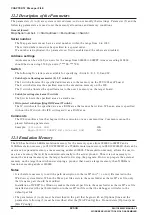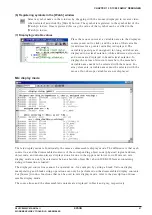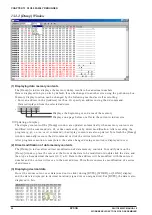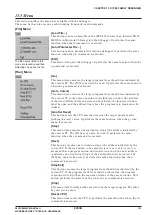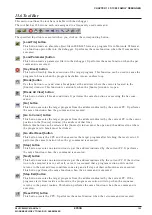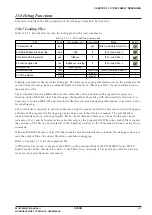
CHAPTER 13 S1C88 FAMILY DEBUGGER
S5U1C88000C MANUAL II
EPSON
99
WORKBENCH/DEV TOOLS/OLD ASSEMBLER
13.4.5 [Register] Window
(1) Displaying register contents
The [Register] window displays the contents of
the S1C88 CPU registers, condition flags and the
memory pointed by the [HL], [SP], [IX], [IY],
[IX+L] and [IY+L] registers.
∗
Updating of display
The display is updated when registers are dumped (rd command), when register data is modified (rs
command), when the CPU is reset (rst command), or after program execution (g, gr, s, se, or n com-
mand) is completed. After program execution is completed, the value changed during execution is
displayed in red.
(2) Direct modification of register contents
The [Register] window allows direct modification of register contents. To modify data on the [Regis-
ter] window, select (highlight) the data to be modified and type a hexadecimal number (0–9, a–f), then
press [Enter]. The register data will be modified with the entered number.
13.4.6 [Symbol] Window
The [Symbol] window can display the symbol list,
if symbol information is loaded.
Symbols are listed in alphabetical order by default.
It can be changed to address order using the "sy /a"
command.
∗
The symbol file is automatically read when a target program file in the Motorola S2 format is loaded.
However, it must be the same name (extension is .sy) and be located in the same directory as the
target program file. Note that a symbol file is not read when an IEEE-695 program file is loaded.
13.4.7 [Watch] Window
The window shows the name and the current value of
the symbol registered using the w command or the
[Source] window [Watch] button. The value is
displayed in the format specified by the w command.
If the symbol is an array, structure, or union, a + icon
is displayed. Clicking this icon displays the array,
structure, or union members hierarchically.
The registered symbols can also be removed or have their display formats changed (e.g., from hexadeci-
mal to decimal) from a menu displayed by right-clicking the symbol. However, display formats can be
changed only for types such as int, char, long, and short, and cannot be changed for addresses. The
addresses are always displayed in hexadecimal notation.
Note that symbol display on this window is possible only when an absolute object file (.abs) in IEEE-695
format containing information on the specified symbol is loaded.
Note: If the -O1 option is specified when compiling, unnecessary symbols may be removed for code
optimization, and no symbol information may be generated. Such symbols cannot be registered in
the [Watch] window.
∗
Updating of display
The display is updated after program execution (g, gr, s, se, or n command) is completed (default).
This condition can be changed so that the display is updated while the program is running using the
dialog box that appears by selecting the [Run | Setting...] menu command (see Section 13.8.4, "Execut-
ing Program").


